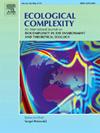A scale-invariant method for quantifying the regularity of environmental spatial patterns
IF 3.1
3区 环境科学与生态学
Q2 ECOLOGY
引用次数: 0
Abstract
Spatial patterns of alternating high and low biomass occur in a wide range of ecosystems. Patterns can improve ecosystem productivity and resilience, but the particular effects of patterning depend on their spatial structure. The spatial structure is conventionally classified as either regular, when the patches of biomass are of similar size and are spaced in similar intervals, or irregular. The formation of regular patterns is driven by scale-dependent feedbacks. Models incorporating those feedbacks generate highly regular patterns, while natural patterns appear less regular. This calls for a more nuanced quantification beyond a binary classification. Here, we propose measuring the degree of regularity by the maximum of a pattern’s spectral density, based on the observation that the density of highly regular patterns consists of a narrow and high peak, while the density of highly irregular patterns consists of a low and wide lobe. We rescale the density to make the measure invariant with respect to the characteristic length-scale of a pattern, facilitating the comparison of patterns observed or modelled under different conditions. We demonstrate our method in a metastudy determining the regularity of natural and model-generated patterns depicted in previous studies. We find that natural patterns have an intermediate degree of regularity, resembling random surfaces generated by stochastic processes. We find that conventional deterministic models do not reproduce the intermediate regularity of natural patterns, as they generate patterns which are much more regular and similar to periodic surfaces. We call for appreciating the stochasticity of natural patterns in systems with scale-dependent feedbacks.
量化环境空间模式规律性的尺度不变方法
生物量高低交替的空间模式出现在多种生态系统中。这种模式可以提高生态系统的生产力和复原力,但模式的特殊效果取决于其空间结构。空间结构通常分为规则和不规则两种,规则是指生物量斑块的大小和间隔相似,不规则是指生物量斑块的大小和间隔相似。规则模式的形成受规模反馈的驱动。包含这些反馈的模型会产生高度规则的模式,而自然模式则不那么规则。这就要求在二元分类法之外进行更细致的量化。根据观察,高度规则模式的密度由一个窄而高的峰值组成,而高度不规则模式的密度由一个低而宽的叶片组成,因此我们建议用模式频谱密度的最大值来衡量规则程度。我们对密度进行了重新标度,使测量结果与图案的特征长度尺度保持不变,从而便于比较在不同条件下观察到的图案或模拟的图案。我们在一项转移研究中演示了我们的方法,该研究确定了以往研究中描述的自然图案和模型生成图案的规律性。我们发现,自然模式具有中等程度的规则性,类似于随机过程生成的随机表面。我们发现,传统的确定性模型并不能再现自然模式的中等规则性,因为它们生成的模式更加规则,类似于周期性表面。我们呼吁在具有规模依赖性反馈的系统中重视自然模式的随机性。
本文章由计算机程序翻译,如有差异,请以英文原文为准。
求助全文
约1分钟内获得全文
求助全文
来源期刊

Ecological Complexity
环境科学-生态学
CiteScore
7.10
自引率
0.00%
发文量
24
审稿时长
3 months
期刊介绍:
Ecological Complexity is an international journal devoted to the publication of high quality, peer-reviewed articles on all aspects of biocomplexity in the environment, theoretical ecology, and special issues on topics of current interest. The scope of the journal is wide and interdisciplinary with an integrated and quantitative approach. The journal particularly encourages submission of papers that integrate natural and social processes at appropriately broad spatio-temporal scales.
Ecological Complexity will publish research into the following areas:
• All aspects of biocomplexity in the environment and theoretical ecology
• Ecosystems and biospheres as complex adaptive systems
• Self-organization of spatially extended ecosystems
• Emergent properties and structures of complex ecosystems
• Ecological pattern formation in space and time
• The role of biophysical constraints and evolutionary attractors on species assemblages
• Ecological scaling (scale invariance, scale covariance and across scale dynamics), allometry, and hierarchy theory
• Ecological topology and networks
• Studies towards an ecology of complex systems
• Complex systems approaches for the study of dynamic human-environment interactions
• Using knowledge of nonlinear phenomena to better guide policy development for adaptation strategies and mitigation to environmental change
• New tools and methods for studying ecological complexity
 求助内容:
求助内容: 应助结果提醒方式:
应助结果提醒方式:


